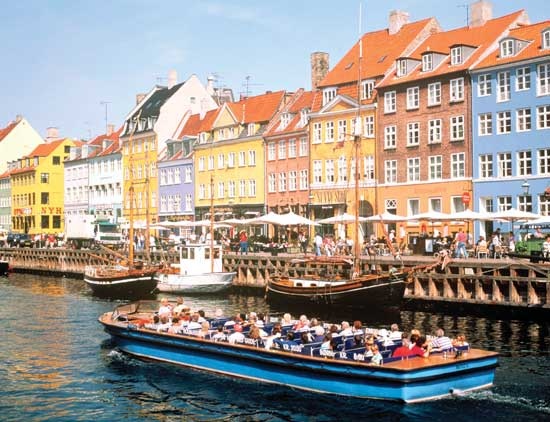Copenhagen
Denmark
Danish København
 capital and largest city of Denmark. It is located on the islands of Zealand (Sjælland) and Amager, at the southern end of The Sound (Sound, The) (Øresund).
capital and largest city of Denmark. It is located on the islands of Zealand (Sjælland) and Amager, at the southern end of The Sound (Sound, The) (Øresund).A small village existed on the site of the present city by the early 10th century. In 1167 Bishop Absalon of Roskilde built a castle on an islet off the coast and fortified the town with ramparts and a moat. In 1445 Copenhagen was made the capital of Denmark and the residence of the royal family. In the civil and religious conflicts of the Protestant Reformation, the town was often sacked. During the late 16th century Copenhagen's trade began to flourish, and the city itself expanded. Among the new buildings erected were the Børsen (Exchange), the Holmens Church, Trinitatis Church, with the adjacent famous Round Tower, and the palace of Rosenborg (now the museum of the royal family). During the wars with Sweden (1658–60) Copenhagen was besieged for two years. Fires in 1728 and 1795 destroyed many houses and buildings, and in 1807 the city was bombarded by the British. The ramparts were pulled down in 1856. Since then the city has expanded still further and incorporated many of the adjacent districts.
The heart of the city is the Rådhuspladsen (“Town Hall Square”). From the square, an old crooked shopping street leads northeast to the former centre of the city, Kongens Nytorv (“King's New Square”), laid out in the 17th century. Buildings there include the Thott Palace (now the French Embassy) and the Charlottenborg Palace (now the Royal Academy of Fine Arts), both of the 17th century, and the Royal Theatre, built in 1874.
Located on the island of Slotsholmen (“Castle Islet”) is Christiansborg Palace, built on the site of the old castle founded by Bishop Absalon in 1167. Since 1928 the palace has been occupied by Parliament, the Supreme Court, and the Foreign Office. Nearby buildings house other government offices. Slotsholmen also contains the Bertel Thorvaldsen Museum, the Royal Arsenal Museum, the state archives, and the Royal Library. The Blue Diamond, an extension of the library, opened in 1999; a modern structure of steel and glass, it lies on the waterfront.
 Other important buildings include the Prinsens Palace, now the National Museum; the Church of Our Lady; the University of Copenhagen, founded in 1479; the Petri Church, used after 1585 as a parish church for the German residents of the city and thoroughly restored (1994–2000); the 17th-century citadel; and the palace of Amalienborg. The botanical gardens laid out in 1874 have an observatory with a statue of the Danish astronomer Tycho Brahe. Other popular sites are the Tivoli amusement park and the Ny Carlsberg Glyptotek, with a fine collection of traditional and modern art. Located at Langelinie Pier is the Little Mermaid statue (1913), which is based on a story by Hans Christian Andersen (Andersen, Hans Christian). A Danish national symbol, it is one of the city's most popular tourist attractions.
Other important buildings include the Prinsens Palace, now the National Museum; the Church of Our Lady; the University of Copenhagen, founded in 1479; the Petri Church, used after 1585 as a parish church for the German residents of the city and thoroughly restored (1994–2000); the 17th-century citadel; and the palace of Amalienborg. The botanical gardens laid out in 1874 have an observatory with a statue of the Danish astronomer Tycho Brahe. Other popular sites are the Tivoli amusement park and the Ny Carlsberg Glyptotek, with a fine collection of traditional and modern art. Located at Langelinie Pier is the Little Mermaid statue (1913), which is based on a story by Hans Christian Andersen (Andersen, Hans Christian). A Danish national symbol, it is one of the city's most popular tourist attractions.The old quarter of Christianshavn is on the harbour to the south. It contains the 17th-century Church of Our Saviour. The western quarter contains the Frederiksberg Park, with its palace and a zoological garden.
For much of the 20th century, Copenhagen and its surrounding areas contained most of Denmark's manufacturing industry. By 2000, however, the city's economy was dominated by public and private services, trade, finance, and education. A number of arterial streets carry traffic toward the centre, across the harbour bridges. There are electric railways (S-baner) for commuters and a network of city bus lines. The last streetcars disappeared in 1972. In the late 1990s construction began on a fully automated subway system in Copenhagen, and the first line opened in 2002. In 2000 the Øresund Link, a combined tunnel-and-bridge system connecting Copenhagen with Malmö, Sweden, opened. It also serves Copenhagen Airport at Kastrup and supports cooperation and regional growth on both sides of The Sound.
In addition to the University of Copenhagen, there are a number of other institutions of higher education. These include the Technical University of Denmark (1829), the Engineering Academy of Denmark (1957), the Royal Danish Academy of Music (1867), the Royal Veterinary and Agricultural College (1856), and the Copenhagen School of Economics and Business Administration (1917). Pop. (2008 est.) urban area, 509,861; mun., 1,153,781.
- Nelligan, Émile
- Nelly Sachs
- Nelson
- Nelson Aldrich Rockefeller
- Nelson Algren
- Nelson-Atkins Museum of Art
- Nelson, Baby Face
- Nelson, Byron
- Nelson, Horatio Nelson, Viscount
- Nelson Lakes National Park
- Nelson Mandela
- Nelson, Rick
- Nelson Riddle
- Nelson River
- Nelson, Samuel
- Nelson W. Aldrich
- Nelson, William Rockhill
- Nelson, Willie
- Nelspruit
- Nelumbonaceae
- Nemanjić Dynasty
- Neman River
- nematocyst
- nematode
- Nemea, Battle of